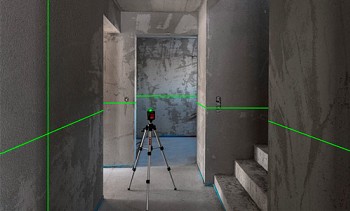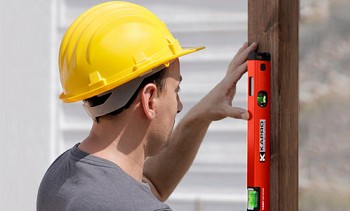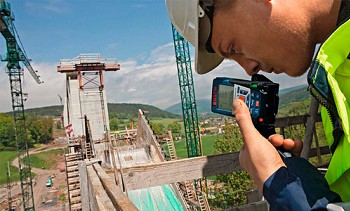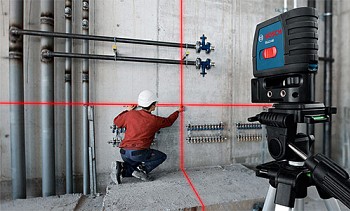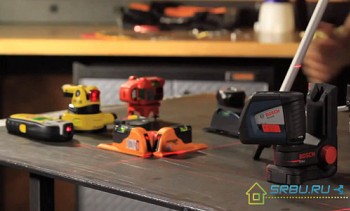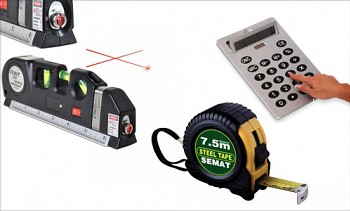Convenient laser levels, allowing you to perfectly accurately markup, are readily acquired by both professionals and amateur craftsmen. Indeed, even bright lines drawn by a laser are perfectly visible even at a great distance. But in a person without experience, the question may arise how to use the laser level correctly. Read about this in this article.
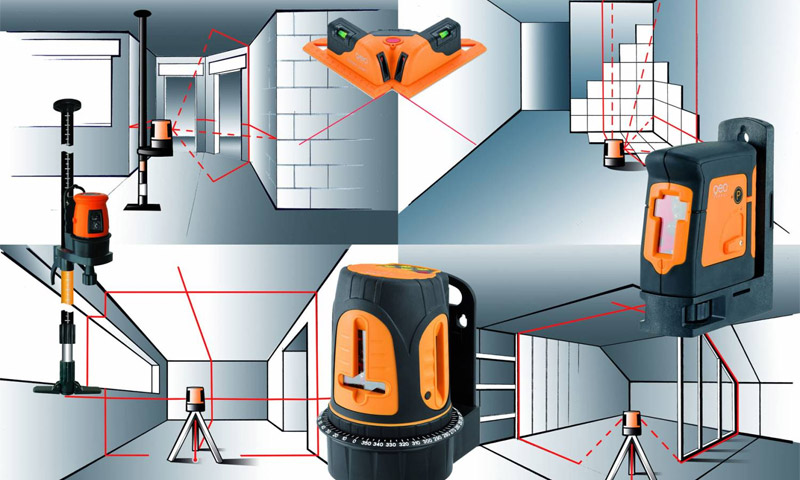
Content:
What you need to do before you get started
Before you start using the device, you must clearly separate with what type of laser levels you have to work with. Although if you bought this device yourself, then you should have known about this at the stage of choosing the laser level.
All laser levels can be divided into:

Static Line Builders (other names - cross-liner or multi-prism builder).

Rotary Line Builders (other names - multi-prism builder, level).

Static Axis Builders (other names - pointer, dot laser).
In principle, most manufacturers write in the instructions (usually included in the kit) how to prepare the device for work. As a rule, no special “dancing with a tambourine” is required - everything is simple and clear.
- If the model is a battery type, then before using it you need to charge the battery.
- If the device runs on batteries, then insert them into the power compartment.
- We check the performance of the level by turning it on. If a laser beam appears, then everything is in order. You can start the installation of the device.
How to bring the laser level into working position
This is important - the quality of the markup directly depends on how correctly the laser level is located. Therefore, you need to find a place suitable for him, and install it properly. There are a number of requirements necessary for the full operation of the device:
Step 1. There should not be any obstacles in the path of the laser beams. Otherwise, the refraction effect will interrupt the projected line.
Step 2 The laser level must be located at the optimal distance to the object. The permissible maximum is indicated in the instructions and should not be exceeded. Reducing the distance reduces the likelihood of error, so try to put the device closer if possible. The allowable maximum can be increased by using a special beam receiver. This option is used when the object is at a great distance.
Step 3 During operation, the level should be on a flat plane (the surface of the table is suitable), a tripod or a special holder. It should be securely fixed, since the complete immobility of the device is a guarantee of obtaining accurate data. No shock or movement is allowed.
Step 4 Before starting the measurements, level the level horizontally. To do this, use the bubble level built into the device. Some models have a self-leveling function. It acts like this: until the device is level, a signal is given. No signal means everything is fine and the device is installed evenly.
Step 5 First you need to warn people nearby about upcoming work. Animals should also be taken away or taken away. After all, accidental contact with the laser in the eyes can injure them.
Step 6 Here, in fact, are all the recommendations. When they are met, you can turn on the level and do the necessary work.
How to set up a laser level
The instructions that came with the device also contain information on how to properly configure the device. The manufacturer describes this process in quite some detail, but is not always clear. In general, setting the laser level is a standard procedure for most models.
Let's start with the simplest levels. Usually they have two or three bubble levels - these devices should be adjusted according to them. This is done by tightening the screws.

However, even if the device is equipped with a self-leveling function, this does not mean that it really aligns itself. This will happen only with a tiny deviation - not more than 10 - 15 degrees. When the surface is more uneven, you have to manually tighten the screws (as with a simple device).
The laser level of the prism type allows you to create two beams projecting vertical and horizontal lines onto the object during operation. They can be emitted at the same time, and it is also possible to choose only one of them. In addition, some models create plumb lines and laser dots (zenith, nadir). They can also be turned on and off.

A rotary laser level, in addition to the above, has two more settings. This is the magnitude of the scanning angle and the rotation speed of the laser beam. At the same time, it only projects a beam in one plane, but some models can project a vertical axis.

Professionals, giving advice on how to work with the laser level, recommend using only the functions that are currently needed when using it. For example, when it is checked how vertical the doorway is, there is no need for a horizontal component. It is possible to leave only a vertical beam - and the battery lasts longer, and less energy is consumed.
Additional devices that facilitate working with the level
Laser beam receiver - increase the range of the laser beam
The laser receiver can help you a lot if you work outdoors. With it, you will see a clear projection of the beam even in blinding sunlight. Moreover, the distance at which the laser "reaches" doubles. Just buy both the laser level and the receiver of one manufacturer, otherwise there are cases of incompatibility of devices of different brands.
If your level is not designed to work with the receiver, then in this case you can find a way out. There is a very simple device - a reflective plate. By fixing it to the object, you can get a slight increase in the range of the beam.

Target - hit exactly on target
The target is a simple accessory that is included with almost all laser levels. A plastic plate with concentric circles drawn on it looks exactly like paper targets for shooting issued in a dash. After all, the goal of both of these targets is the same - to hit the "bullseye". Well, you can shoot not only with bullets, but with a laser beam.

Such a thing is very useful when the distance between the level and the object is large enough. For example, you need to make a hole in the wall a few centimeters higher than in the opposite, while the distance between the walls is 40-50 meters. Try to see the traces of a pencil or marker at such a distance! If you fix the target instead, then aiming at it with a beam is not difficult. Even if the shooter is not particularly accurate.
Some levels have in the kit one more device that improves the accuracy of the laser “shot”. This is a kind of optical sight located on the body of the device. It is called an optical sighting device, and with its help you can easily "reach" the target even at a hundred-meter distance.
Rail - we draw perfectly straight lines
A rail is useful when you need to draw several parallel lines on the surface of the object, the distance between which is the same. And with the help of a rack, the height of the level fixed on a tripod is changed.Then he can return to its original position.
Laser level in practice: some specific examples of use
By asking an experienced craftsman how to use the laser level, you can find out that you can use this device almost everywhere. And the boundaries that determine the possibilities of its use are the boundaries of your imagination. And now - a little specificity.
Leveling the surface - vertical projection
It is this area of application that clearly shows how outdated all kinds of rulers, roulettes and bubble levels are.
To find out how even your floor or walls are, you need to direct a laser beam along their surface. At the same time, along the wall (if we check the wall), we put several control marks.
The line drawn by the beam will show the deviation from the vertical in each mark. In accordance with these data, we select the thickness of the leveling layer at all control points.

Tile applications - cross projection
We include both beams - vertical and horizontal. Crossing, they project a cross on the wall of the object. We combine the center of this cross with the central seams of the tiles that we put. And along the lines of laser beams, align the sides of the tile.

Construction of inclined planes
Not all elements of the house consist only of horizontal and vertical lines. Sometimes a designer wants to experiment with planes located at an angle. With such bold projects, the laser level will come in handy. Read the instructions for your device carefully, and you will understand how to make the beam go at an angle.
In those levels where the automatic leveling system is used, it is necessary to enable locking of this system. Some levels are equipped with a system for automatically changing the angle of the beam. For example, if you disable the tilt compensation lock, it is quite possible to fix the level on a tripod at the angle that is required. The laser beam will be inclined.

Glue wallpaper and other decorative elements
And for this simple operation, the laser level is useful. So, turning on the vertical beam, we can easily align the vertical edge of the wallpaper. A horizontal beam will help to make an ideal border, which without using a tool often turns out to be crooked.

We install furniture and build in household appliances
An unevenly hanging shelf or a hanging cabinet can cause a lot of disappointments - they spoil the whole look of the room. Of course, you can outweigh them using the usual bubble level or even a ruler. But it is long and troublesome. Whether the case is a laser level. He and the cabinet will help to install it evenly, and hang the cornice, and precisely position the built-in appliances. The main thing is that all this is done very quickly.

Installation of partitions and layout of premises
Having a laser level, you can “redraw” a room in a short time. To mark the location of the partitions, you do not have to take a stepladder or crawl on the floor. It is enough to make a projection of the laser beam in the place where the future partition will be located.

Measurement Application
It is not possible to directly measure something with a level. But it can significantly facilitate and accelerate this work. Take, for example, a room whose walls are not vertical. If you need to know its height, a problem arises - you can’t do this along the wall. It’s nice to use a laser rangefinder, but it may not be.
If there is a laser level that projects a plumb line, then it can also help. Having thus received two points - on the floor and the ceiling - we take a tape measure or ruler and measure the distance between them. It turns out a very accurate room height.
Remember safety
It would seem that it can be dangerous in such a harmless thing. However, the power of the laser beam used in this device is quite large. Otherwise, we will not see him in the afternoon, in the light of the sun. Therefore, remember that the beam should not get into the eyes of people or animals.And while working, always wear safety glasses - with them, by the way, the beam is better seen.

